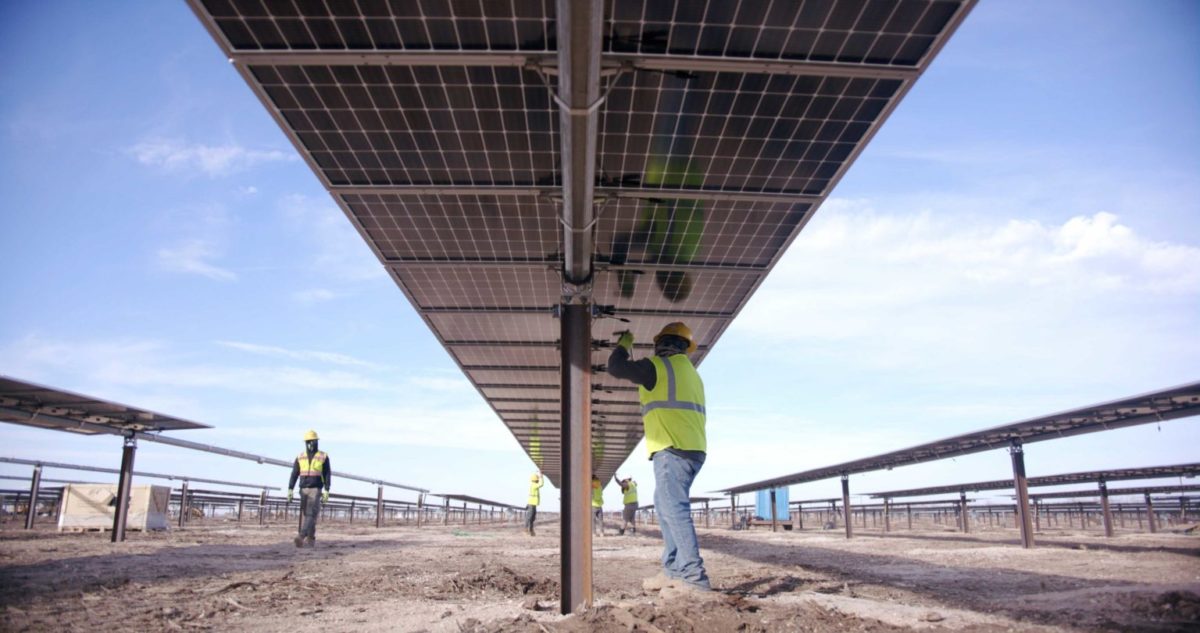From pv magazine USA
The US Energy Information Administration’s (EIA) monthly update of capacity additions shows that the energy transition is well underway. Across the United States, projects listed as actively under construction total more than 25.4 GW in capacity. This adds to the 107.5 GW of existing solar on the US grid that exists today, as reported by the EIA.
Small-scale solar projects of 1 MW or less total an estimated 39.5 GW nationwide, while utility-scale projects above that threshold total nearly 68 GW, reports EIA. There are currently 366 utility-scale projects actively being built across the United States as of the most recent EIA data release. The average size of these projects is 69 MW. Of this total, 166 projects are listed as 50% complete or more, adding 10.2 GW of capacity.
The largest project under construction is Gemini Solar, developed by Primergy, a Quinbrook Infrastructure company. This project will add 690 MW to the Nevada grid once complete. The next seven largest projects are all located in Texas, averaging 405 MW in capacity.
Texas is a dominant state for utility-scale solar project construction, with 28 projects totaling 6.7 GW in capacity, with about 240 MW as an average project size. The state’s largest active project is 500 MW.
Florida is making significant headway in the utility-scale project construction space. Just under 5 GW of capacity is currently being installed across 68 projects, averaging 73.4 MW in size. Notably, project designs are very uniform in Florida, with 65 of these projects ranging from 74 MW to 75 MW in capacity.
California follows with 3.2 GW of projects actively under construction, with a greater emphasis on distributed projects. EIA reports 45 projects underway with an average nameplate capacity of 75 MW. The state’s largest active project is 300 MW.
Another 1.96 GW of projects nationwide have been fully constructed and are awaiting final approvals to reach commercial operation. There are 48 projects that fall into this bucket, averaging 41 MW in capacity. Eight of these projects are 1 MW solar facilities in Minnesota, a market known for its standout performance in community solar projects of this size.
Solar energy is now in the center stage of the US plans for a decarbonized economy, representing 70% of high-probability utility-scale power capacity planned through 2025.
Solar’s rise to the top as a key energy resource now seems inevitable, but its fate was not always sealed. The technology contributed a negligible amount of power less than ten years ago, and the EIA did not begin reporting annual net generation of PV until 2014. In that year, solar contributed 27 TWh of electricity to the U.S. grid. Seven short years later, it generated 164 TWh in 2021, multiplying generation six times over.
This progress has been made possible by supportive industrial policy, economies of scale, improved technological efficiencies, and business innovations. The levelized cost of electricity (LCOE) has fallen over the years, and the benefits of solar and energy storage become more crystalized as the threats of climate change increase with the passing years.
Looking ahead, project construction is expected to continue to accelerate. The Inflation Reduction Act of 2022 contains $370 billion in spending for renewable energy and climate measures and calls for a 40% reduction in carbon emissions by 2030. Princeton University released a Rapid Energy Policy Evaluation and Analysis Toolkit (REPEAT) in collaboration with Dartmouth College, Evolved Energy Research, and Carbon Impact Consulting, outlining the potential impact of the law.
The impact on the US solar industry could be huge, to say the least. The Princeton report said solar deployment may accelerate from 2020 rates of 10 GW of capacity added per year to nearly five times as much by 2024, adding 49 GW of utility-scale solar each year. Solar deployment may be well over 100 GW per year by 2030, said Princeton.
Investment in solar could reach $321 billion in 2030, nearly double the figure of $177 billion expected under current policy. The IRA would lead to nearly $3.5 trillion in cumulative capital investment in new American energy supply through the next decade, said the report.
This content is protected by copyright and may not be reused. If you want to cooperate with us and would like to reuse some of our content, please contact: editors@pv-magazine.com.




2 comments
By submitting this form you agree to pv magazine using your data for the purposes of publishing your comment.
Your personal data will only be disclosed or otherwise transmitted to third parties for the purposes of spam filtering or if this is necessary for technical maintenance of the website. Any other transfer to third parties will not take place unless this is justified on the basis of applicable data protection regulations or if pv magazine is legally obliged to do so.
You may revoke this consent at any time with effect for the future, in which case your personal data will be deleted immediately. Otherwise, your data will be deleted if pv magazine has processed your request or the purpose of data storage is fulfilled.
Further information on data privacy can be found in our Data Protection Policy.